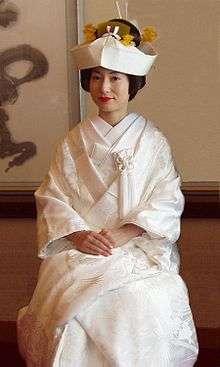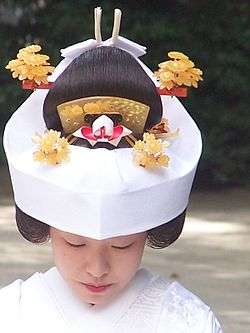Shinto wedding
Shinto weddings, Shinzen kekkon (神前結婚, "Marriage before the kami"), began in Japan during the early 20th century, popularized after the marriage of Crown Prince Yoshihito and his bride, Princess Kujo Sadako. The ceremony relies heavily on Shinto themes of purification, and involves ceremonial sake drinking of three cups three times, the nan-nan-san-ku-do. Shinto weddings are in decline. Fewer Japanese people get married, and those who do often choose Western-style chapel ceremonies.
The ceremony

A Shinto wedding ceremony is typically a small affair, limited to family, while a reception is open to a larger group of friends.[1]
Shinzen kekkon, literally "wedding before the kami," is a Shinto purification ritual[2] that incorporates the exchange of sake between the couple before they are married.[1] The ceremony typically takes 20 to 30 minutes.[3]
Food items, including salt, water, rice, sake, fruit, and vegetables, are left at a ceremonial wedding altar, which also holds the wedding rings.[1][4]
A Shinto priest stands to the right of the altar, while a shrine maiden, Miko, stands to the left. The couple will often stand in the center of the room, while closest family members stand behind tables containing sake and small fruits.[4]
The priest will purify the shrine and call the attention of benevolent spirits, or kami.[4] Then, the priest announces the beginning of the san-san-ku-do ceremony,[4] or "three-three-nine-times," reflecting three oaths taken three times,[5] represented by three cups, poured three times, and swallowed in three sips.[3] This often includes three pourings from three cups of increasing sizes.[3] The first, smallest cup, is first poured to the groom, who drinks from it before offering it to the bride.[5] The second pouring goes first to the bride, then to the groom. The final pouring goes from the groom first, then the bride (essentially repeating the first pour).[4]
The sake aspect of the ceremony is said to be the core of a Shinto wedding.[4] The ritual may have originated at samurai weddings, though the symbolism of the action and numbers has no clear origin.[4] Some see the ritual as representative of sharing joys and sorrows as a married couple,[6] others suggest that san-san is a homonym for "birth after birth," suggesting fertility symbolism.[7] Still others suggest it represents man, woman, and child, or heaven, earth and man.[4]
The couple approaches the altar, where the groom reads his vows while the bride listens.[1][4] Reflecting a history of arranged marriage in Japan, a nakodo, or "matchmaker," will be thanked in the vows.[1][3] If no matchmaker exists, a friend or family member will be appointed to fill the role,[1] serving a role similar to the "best man" or "bridesmaid."[3] Then, the families join in with the drinking of sake and a traditional cheer of "kampai."[4]
In the final portion of the ceremony, the priest offers Japanese evergreen to the altar, said to reflect gratitude to the spirits who blessed the union.[1][4] The bride and groom follow with their own offering, then a representative from each family (often the fathers of the bride and groom).[4] The rings are then presented.[4]
Within wedding prayers, the gods Izanagi and Izanami are often invoked.[1] These married gods were part of the Japanese lore of the "first wedding," and are called upon to reflect a harmonious balance within the marriage.[1] Other aspects of the Shinto wedding prayer include calling for the couple to work to maintain a respectful home, and for the couple to have children.[1][8]
Costume
Shinto brides and grooms typically wear kimono; the bride wears either a Uchikake kimono (打ち掛け, lit. "knockout") (a thick, colourful (mainly red), heavily-brocaded, highly-formal kimono, worn outside the actual kimono and obi, unfastened, as a sort of overcoat), or a Shiromuku kimono (白無垢, lit. "white pure-innocence") (typical colours for these kimono include red and white, colours of Shinto purity and good luck.[4]), oftentimes combined with a wig[1]. The bride may change into a red kimono for the Wedding reception events after the ceremony for good luck.


There is also a headdress; either a Tsunokakushi (角隠し, lit. "horn-hiding"), a headdress made from a rectangular piece of cloth, often made of white silk (to match the bride's shiromuku kimono), which covers the bridal high topknot (a Bunkin Takashimada), a kind of chonmage (a traditional topknot); they're traditionally worn to veil the bride's metaphorical 'horns of jealousy, ego and selfishness', and also symbolizes the bride's resolve to become a gentle and obedient wife[3]; or a wataboshi (綿帽子, lit. "cotton hood"), an all-white hood or cowl, worn as an alternative to the tsunokakushi, and the Japanese equivalent to the Western marriage ceremony's bridal veil; its purpose is to hide the bride's face from all others, except for the bridegroom, until the end of the wedding ceremony. It was adapted from the katsuki, a hood worn outdoors to keep away dust and prevent from the cold, by married women in samurai families, from the Muromachi to Momoyama periods, before being taken up by younger women from the Edo period onwards. Like the shiromuku its worn in concert with, the wataboshi is a symbol of innocence and purity; its worn only outside in outdoor receptions with the shiromuku-only, not with coloured wedding iro-uchikake kimono, or during indoor receptions.
Origins and early history
The Shinto wedding is a modern invention. The first mention of a wedding in a Shinto manual was in 1872; weddings are not reported until the 1880s.[1] These weddings were limited to the families of Shinto priests.[1] Earlier Shinto weddings were a family gathering without religious significance, aside from the occasional appearance of female dancers, katsurame, said to protect the bride from demons.[1]
Scholars suggest that the adoption of religious wedding ceremonies was driven by the decline of state-sponsored Shinto shrines during the 1880s.[1] A rash of new ceremonies emerged in this period, including visits for newborns and on certain birthdays.[1][9]
The wedding of Prince Yoshihito
Prince Yoshihito married Kujo Sadako in a Shinto ceremony at the Imperial Palace in 1900, one of the first ceremonies of its kind.[1] The wedding reflected a change in Meiji-era thinking about marriage, which had recently legally allowed for marriage to be a balanced partnership between husband and wife.[1][4]

The next Shinto wedding ceremony was performed at Tokyo's Hibiya Daijingu shrine in 1901.[1] Later, shrines such as Ueno Shimotani and Tokyo's Izumo Grand Shrine hosted wedding ceremonies.[1] These ceremonies, concentrated in Tokyo, were still limited to elites.[1][10] Soon, wedding ceremonies were performed in more cities, starting in Osaka and Kyoto, and began to attract the donation of larger dowries.[1][10]
Post-war weddings
After being stripped of its status as a state religion in 1945, there came a rapid rise in the democratization of Shinto wedding ceremonies, and, in turn, the number of people choosing them.[1] This also reflected a mass movement of families into cities and smaller homes, which made it more difficult to host domestic ceremonies.[1]
This period also saw the rise of the commercial wedding industry, which grew out of collaboratives that lent large venues for wedding ceremonies.[1]
Contemporary Japanese weddings
Japanese Shinto weddings are overseen by priests, but often take place in hotels or in special venues designed to accommodate weddings.[1] As Japan's marriage rate declines, fewer Shinto weddings are being performed; the number has dropped from 90% of ceremonies to 50% since the 1990s.[11] Japanese weddings more often reflect a Christian wedding ceremony, regardless of the personal faith of the married couple.[1][12]
In 1999, two gay men were married in a Shinto ceremony at Kanamara Shrine in Kawasaki, but gay weddings have not been widespread in Shinto shrines, and the position of the Association of Shinto Shrines on gay weddings is vague.[13]
See also
- Family law in Japan
- Women in Japan
- Same-sex marriage in Japan
References
- Ambros, Barbara (2015). Women in Japanese Religions (1 ed.). New York: New York University Press. pp. 127–128. ISBN 9781479884063.
- Picken, Stuart D.B. (1994). Essentials of Shinto : an analytical guide to principal teachings. Westport, Conn. [u.a.]: Greenwood Press. ISBN 9780313264313.
- De Mente, Boyé Lafayette (2009). Etiquette guide to Japan know the rules that make the difference (Updated and expanded ed.). North Clarendon, Vt.: Tuttle Pub. ISBN 9781462902460.
- Hendry, Joy (2010). Marriage in Changing Japan: Community & Society. Routledge. ISBN 9781136898006.
- Lebra, Takie Sugiyama (1985). Japanese women : constraint and fulfillment (Pbk. ed.). Honolulu, HI: University of Hawaii Press. ISBN 9780824810252.
- Tamura, Naomi (2010). The Japanese Bride. Nabu Press. ISBN 9781144993410. Retrieved 31 December 2015.
- Bownas, Geoffrey; Brown, Pauline (2013). Japanese rainmaking and other folk practices. [S.l.]: Routledge. ISBN 978-0415866699.
- Masahiko, Asoya (2006). "Shinto no kekkonkan ("Wedding Parties in Shinto")". Heiwa to Shuukyou. 25: 61–63.
- Hardacre, Helen (1991). Shintō and the state, 1868–1988 (1st paperback print. ed.). Princeton: Princeton University Press. ISBN 978-0691020525.
- Ishii, Kenji (2006). "Shinzenkekkonshiki ni miru "ie" no henbou to kojin no shoushutsu". Meiji shoutoku kinen gakkai kiyou (in Japanese). 43: 95–98.
- Goldstein-Gidoni, Ofra (1 April 2001). "Hybridity and distinctions in Japanese contemporary commercial weddings". Social Science Japan Journal. 4 (1): 21–38. doi:10.1093/ssjj/4.1.21via Oxford University Press (subscription or UK public library membership required)
- Fisch, Michael (2001). "The Rise of the Wedding Chapel in Japan: Simulation and Performance". Japanese Journal of Religious Studies. 28 (1–2): 58, 64–65, 70–75. JSTOR 30233676.
- Fish, Isaac Stone (29 June 2015). "Does Japan's Conservative Shinto Religion Support Gay Marriage?". Foreign Policy. Foreign Policy. Archived from the original on 21 December 2015. Retrieved 29 December 2015.